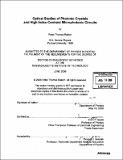Optical studies of photonic crystals and high index-contrast microphotonic circuits
Author(s)
Rakich, Peter Thomas
DownloadFull printable version (44.17Mb)
Other Contributors
Massachusetts Institute of Technology. Dept. of Physics.
Advisor
Erich P. Ippen.
Terms of use
Metadata
Show full item recordAbstract
Both high index-contrast (HIC) photonic crystals and HIC microphotonic circuits are presented in this thesis. Studies of macro-scale 2D photonic crystal meta-materials are first described. Through comparison of experimental and theoretical beam evolution about the super-collimation frequencies, the effects of disorder on beam evolution are pinpointed. Despite the effects of disorder, super-collimation is found to be robust, producing stationary beam-widths over 600 isotropic diffraction-lengths. In addition, nano-scale photonic crystal defect modes are studied over large optical bandwidths through newly developed supercontinuum based techniques. Novel all-fiber supercontinuum sources facilitate the generation of unpolarized supercontinuum light over 1.2-2.0 micron wavelengths. Broadband experimental methods make possible the application of these sources to the study of 1D and 3D photonic crystals with defect states. Studies of both static and dynamic microring resonator based HIC filters are described. Numerous microring based studies are reported which lead to frequency-compensated multi-ring filters, permitting the first high-fidelity microring filters in HIC microphotonics. (cont.) Though telecom-grade performance achieved via frequency compensation, the aforementioned filters exhibit severe polarization sensitivities, making them incompatible for real-world applications. Through integration of identical sets of these filters in a generalized polarization diversity scheme, polarization insensitive HIC filters are demonstrated for the first time, yielding a maximum polarization dependant loss of 2.2 dB over broad bandwidths. Finally, evanescent field-perturbation is investigated as a means of tuning microcavities over ultrawide wavelength ranges. Through nano-metric control of a silica perturbing body in the near-field of a microring waveguide, a 27 nm (or 1.7%) reversible tuning of its cavity mode is achieved.
Description
Thesis (Ph. D.)--Massachusetts Institute of Technology, Dept. of Physics, 2006. Includes bibliographical references (p. 137-143).
Date issued
2006Department
Massachusetts Institute of Technology. Department of PhysicsPublisher
Massachusetts Institute of Technology
Keywords
Physics.